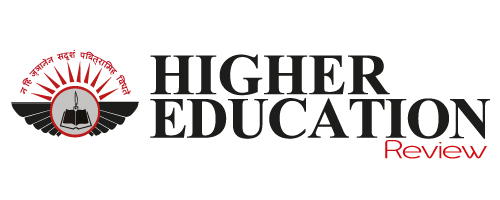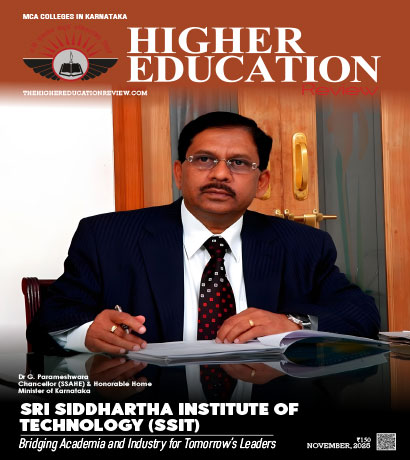Scalable Talent Development: From Students to Professionals
 In a conversation with Higher Education Review, S. Alex Melwyn, Head-Training, AAM Business School, shared his perspective on preparing students to meet the evolving needs of industry by developing the right skills through appropriate training and practical learning. He discussed the importance of practical skill development, familiarization with real-world situations, and the deployment of academic frameworks that achieve industry expectations. With over 15 years in Learning & Development and Human Resource Development, Alex currently leads the academic operations at AAM Business School and is responsible for scheduling, curriculum planning, and implementation of institutional programs.
In a conversation with Higher Education Review, S. Alex Melwyn, Head-Training, AAM Business School, shared his perspective on preparing students to meet the evolving needs of industry by developing the right skills through appropriate training and practical learning. He discussed the importance of practical skill development, familiarization with real-world situations, and the deployment of academic frameworks that achieve industry expectations. With over 15 years in Learning & Development and Human Resource Development, Alex currently leads the academic operations at AAM Business School and is responsible for scheduling, curriculum planning, and implementation of institutional programs.
How can schools and universities align curricula with future workforce needs without sacrificing foundational learning?
In the current workforce, knowledge and skills are prominent factors. Many universities and colleges are working diligently to align skill expectations in the workplace with what is taught in the academic context. When a college or university develops its curriculum according to an industry’s needs, it can align the knowledge imparted to the organization’s expectations. Universities and colleges are adding value to traditional degrees with additional certifications, which are also adding value to the students’ employability and experience.
What role should experiential learning (internships, apprenticeships, etc.) play in talent development pipelines? How can technology personalize learning pathways for students to build scalable, industry-ready skills?
Experiential learning is essential for training and development. The human brain absorbs knowledge more effectively through active engagement - listening, visualizing, and especially through sharing information. Experiential learning is required in all forms of skill-based training. Internships are another form of experiential learning from the organizational perspective since they provide structured training and real-time knowledge transfer. Internships offer the opportunity for freshers to participate in practical learning based on the expectations of industry standards. Self-paced learning allows learners to access training at their own pace and time. This also represents a significant change in the experience of training and development.
What scalable strategies can organizations adopt to bridge the skill gap between graduates and job roles? How can companies ensure continuous upskilling without disrupting employee productivity?
Organizations are beginning to adopt competency-based models to scale skills. Organizations are becoming more deliberate about training and communicating their expectations to employees with more clarity. Unlike earlier times when communication gaps existed, there is more transparency regarding skill requirements, allowing the current generation of employees to better understand organizations’ objectives.
To develop the skills of employees across multiple job profiles, many organizations are giving employees access to open learning, such as Great Learning, as a way to invest in upskilling. Open learning allows for self-paced learning and allows employees to choose courses based on interests or aspirations, or career pathways. Currently, organizations are using microlearning, which means providing short content segments to an employee, rather than long training sessions. Microlearning provides employees with the ability to learn certain knowledge and skills in the shortest time. These approaches are indicative of the attempts by many organizations to make learning more relevant, flexible, and aligned with the requirements in today’s workforce.
What models of collaboration between academia and industry have proven most effective for talent development? What policies are needed to support scalable talent development from rural areas to urban centers?
Institutions are clearly outlining their requirements, which enable organizations to develop curricula that address those requirements, creating a clearer pathway for students from education to employment. A positive development in this area is the active involvement of industry experts with academic institutions, where they contribute by delivering training sessions. This partnership allows organizations to share resources, while institutions utilize these inputs to adopt effective and relevant teaching techniques.
With continued technology innovations and different software applications, talents from every part of the world can be accessed and utilized effectively regardless of location. These innovations allow a more mutual approach to view organizational requirements across the globe, especially around talent acquisition and workforce readiness. If organizations share their job expectations, learners know what skills are required, and institutions can tailor their educational programs; this could create a more vibrant and coordinated ecosystem. This alignment allows for formal education outcomes aligned to industry needs, which ultimately improve employability and professional development.
How can governments and industry co-invest in lifelong learning infrastructure at scale? What frameworks can ensure equitable access to reskilling and upskilling opportunities for underrepresented groups?
The industry is partnering with the government in several ways, and numerous initiatives are being developed by both parties to support the entire journey, from establishing a full-fledged organization to securing funding and managing the business. Many of these entrepreneurs emerge from the industry and possess significant raw talent; they simply require the right environment to nurture and develop their potential. In addition, many skill-based programs are being built in collaboration between the government and the industry. These programs are designed through mutual consultation and aim to align with industry needs.
Students need to know that there are opportunities for them and that companies are actively looking to recruit them. Identifying the right university or college that can guide students through this process is essential. Institutions are ideally positioned to recommend people for work and to give them the opportunity to train. Institutions can start the recruitment process equally for all individuals of diverse backgrounds. Accessing the industry is much easier when the approach is made through an institution. Raising this awareness is necessary to create opportunities for individuals to leverage the greater opportunities available.
What are the risks of scalability in talent development - standardization vs. individuality?
Organizations face challenges in identifying the right talent. When individuals have potential, it is the responsibility of educational institutions to develop their capacities to come in line with industry expectations. The industry needs competent professionals, and so there is a shared responsibility for institutions and organizations to create a collaborative process. If companies are trying to find talent, then they also need to recognize the institutions that support their efforts to prepare and provide well-trained candidates.
Many colleges and universities are now working collaboratively to standardize. Standardization aims to provide students with general, relevant skills that are valued by industry and can help them better gain employment and develop in their careers. The vision of standardization is clear, but the timeline for implementation is an ongoing process. It is a lifelong process and will require time, collaboration, and consistent work by all parties to realize this effort.
Can micro-credentials and modular learning replace traditional degrees for certain career paths?
The concept of replacing long-term programs with short modules is called micro programs or "nuclear" programs. Today’s generation has a shorter attention span and less time for longer learning experiences. Typically, shorter programs can be more effective in capturing and maintaining learner engagement. However, the scalability and the depth of talent development should not overwrite the necessary structure of the learning timeline. The level of training effectiveness is driven by whether there is enough time for the learner to absorb, understand, and apply that knowledge.
Building skills takes time and progresses through phases - from knowledge acquisition to demonstration, and ultimately to application. To enhance effectiveness, the focus can shift from covering a wide range of skills to developing a single skill in depth, from the foundational level to full proficiency.

